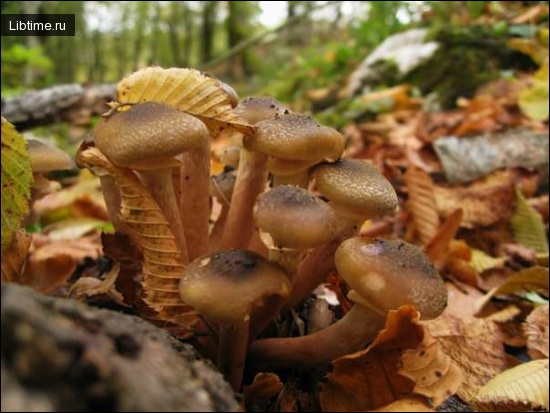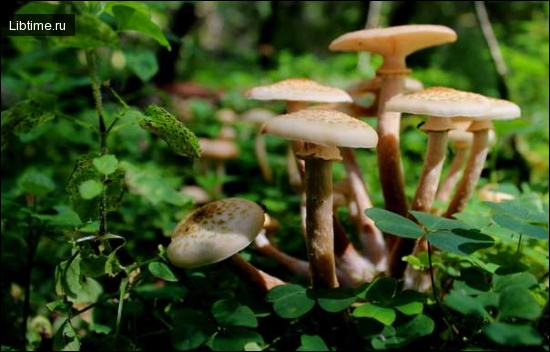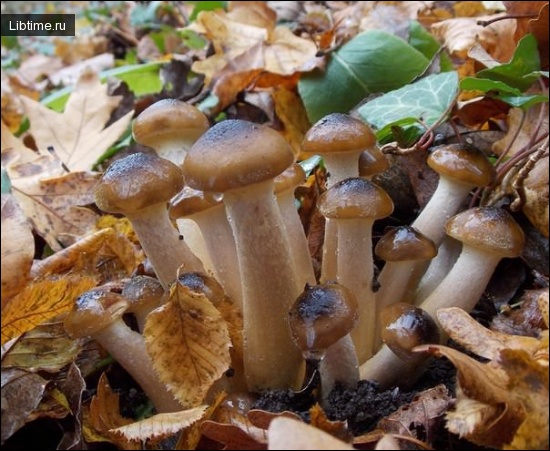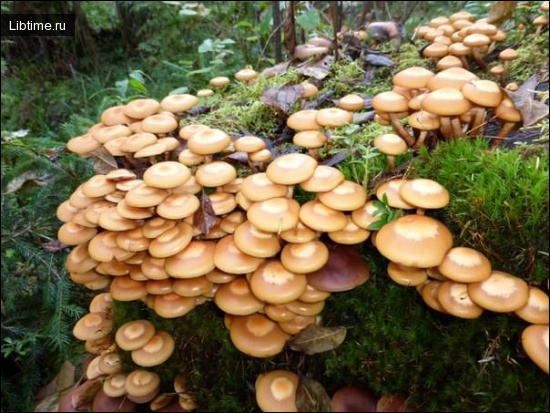Mushrooms. Photo
Although some of their species are also found among. We will describe them and photo.
Mushrooms mushrooms belong to. These small agaric mushrooms resemble a fabulous army storming an enemy fortress - a rotten stump or tree. Honey mushrooms are called the gravediggers of the forest. Having settled on rotten stumps, they gradually move on to healthy trees, which begin to get sick and die after 10-15 years.
These mushrooms can be seen on stumps, roots, windfall, near the trunks of oaks, birches and aspens. They are easy to collect. Mushrooms grow in large groups: sometimes in one family there are up to a hundred mushrooms fused with the bases of the legs.
autumn honey agaric
On the picture - autumn honey agaric. The hat of the autumn mushroom at first has a spherical, convex, then prostrate shape, dotted with small fluffy brown scales, dirty brown or yellowish gray, darker towards the middle, diameter from two to eight centimeters. In young mushrooms, the spore-bearing layer is covered with a white film, which later breaks, leaving a small ring on the stem. White or light brown plates are often covered with rusty spots. The leg of the honey agaric is long, dense, thin, white at the cap, and dark brown at the base. The pulp is white, dense, has a pleasant smell and a sour-astringent taste.

It should be noted that the legs of mushrooms, especially in adults, are hard and fibrous. Therefore, it is recommended to eat mostly hats. The legs, along with cut large hats, go well in fried dishes.
In shaded and damp lowlands, on old stumps of birch, aspen or oak, you can see large close groups summer mushrooms. In the photo - summer mushrooms.

Summer mushrooms are so named because they sometimes appear in June and grow all summer. In dry summers, this fungus is rare, although there are years when it grows quite amicably. He has the most intensive growth in September. The shape and size of the summer mushroom does not differ from the autumn one. The difference lies in the fact that the color of his hat is more yellow than that of the autumn honey agaric and the hat is devoid of the scales characteristic of the autumn honey agaric.
Summer mushrooms are boiled, fried, pickled, dried and salted.
Winter honey agaric
At the end of September, the latest mushroom growing in our forests begins to appear - honey agaric winter, or winter mushroom. his photo is shown. It grows in close groups until December in deciduous or mixed forests, in gardens, parks, on stumps, tree trunks.

The hat of the honey agaric is round-convex, slimy, thin-fleshed, tucked inward, like that of the autumn honey agaric, with age it is prostrate, orange-yellow-red, reddish-brown, creamy, smooth, darker in the center, two to ten centimeters in diameter. The leg is dense, cylindrical, yellowish above, brown, fibrous below the base, up to one and a half centimeters in diameter, four to ten centimeters long. The plates are wide, sparse, whitish (cream or yellowish), later turning brown. The flesh of the fungus is white or yellowish, does not darken on the cut, has a pleasant smell and taste. Only winter mushroom caps are edible, which are especially tasty fried, in soups and sauces.
Honey mushrooms - False mushrooms
In the autumn forest, poisonous false mushrooms. Here is their photo. In order to avoid a fatal mistake, you should remember well distinguishing features of edible and false mushrooms.
- Autumn honey agaric has a brownish-yellow, dull, scaly cap. On the stem is a white membranous ring. The plates are white, brownish. Edible.
- Hat at summer honey agaric yellow-brown, smooth, the leg has a ring of the same color with a cap, the plates are white, reddish-brown. Edible.
- Winter honey agaric has a hat orange-yellow, reddish, rusty-brown in the center, smooth. Leg without membranous ring, plates are white, yellowish. Edible.
- At false sulphur-yellow honey agaric the hat is bright, yellow-orange, rusty in the center, smooth. The leg is covered with a brown ring, the plates are yellow-green, dirty olive. Poisonous.
- False brick red honey agaric has a red-brown, bright, smooth hat, a leg without a membranous ring, light or cap-colored plates, wide. Poisonous.
